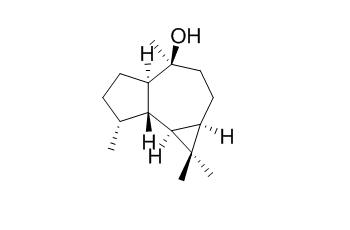Epiglobulol
Epiglobulol shows antibacterial activities, it can strongly inhibit the growth of foodborne microorganisms. Epiglobulol can inhibit the recombinant human UDP-glucuronosyltransferase (UGT) 2B7, it may serve as valuable lead structures for the design of potent inhibitors for UGT2B7.
Inquire / Order:
manager@chemfaces.com
Technical Inquiries:
service@chemfaces.com
Tel:
+86-27-84237783
Fax:
+86-27-84254680
Address:
1 Building, No. 83, CheCheng Rd., Wuhan Economic and Technological Development Zone, Wuhan, Hubei 430056, PRC
Providing storage is as stated on the product vial and the vial is kept tightly sealed, the product can be stored for up to
24 months(2-8C).
Wherever possible, you should prepare and use solutions on the same day. However, if you need to make up stock solutions in advance, we recommend that you store the solution as aliquots in tightly sealed vials at -20C. Generally, these will be useable for up to two weeks. Before use, and prior to opening the vial we recommend that you allow your product to equilibrate to room temperature for at least 1 hour.
Need more advice on solubility, usage and handling? Please email to: service@chemfaces.com
The packaging of the product may have turned upside down during transportation, resulting in the natural compounds adhering to the neck or cap of the vial. take the vial out of its packaging and gently shake to let the compounds fall to the bottom of the vial. for liquid products, centrifuge at 200-500 RPM to gather the liquid at the bottom of the vial. try to avoid loss or contamination during handling.
Korean. J. Pestic. Sci.2024, 28(3):241-248.
Int J Mol Sci.2021, 22(19):10405.
TCI CO.2019, US20190151257A1
Int Immunopharmacol.2024, 141:112906.
Int J Cosmet Sci.2022, doi:10.1111/ics.12827.
Environ Toxicol.2019, 34(12):1354-1362
PLoS One.2015, 10(5):e0127060
Environ Toxicol.2020, doi: 10.1002
J Chromatogr B Analyt Technol Biomed Life Sci.2019, 1126-1127:121743
Chemistry of Natural Compounds2018, 204-206
Related and Featured Products
J Agric Food Chem. 2004 Feb 25;52(4):781-7.
Volatile constituents from the leaves of Callicarpa japonica Thunb. and their antibacterial activities.[Pubmed:
14969531 ]
Volatile substances of Callicarpa japonica Thunb. were examined for their antibacterial activities against six foodborne microorganisms using the optical densitometer Bioscreen C.
METHODS AND RESULTS:
Extracts of C. japonica were obtained by simultaneous steam distillation and solvent extraction (SDE), and those extracted for 1.5 and 2.0 h at pH 6.0 strongly inhibited the growth of Bacillus cereus and Salmonella typhimurium; the content of the volatile substances of leaves at these pH levels were 543.1 and 706.7 mg/kg, respectively. All foodborne microorganisms tested were strongly inhibited by the addition of >8% (v/v) of the SDE extracts to broth medium. The major volatile components of the SDE extracts obtained at 1.5 h and pH 6.0 were gamma-caryophyllene, 1-octen-3-ol, 2-hexenal, germacrene B, and aromadendrene II, with corresponding peak areas of 44.14, 15.6, 9.86, 5.24, and 4.01%, respectively, and major antibacterial components were 1-octen-3-ol and 2-hexenal.
CONCLUSIONS:
Among the 32 materials identified as volatile flavor components, 2-hexenal, 2,4-hexadienal, 1-octen-3-ol, 2,4-heptadienal, and Epiglobulol strongly inhibited microorganism growth. In particular, 2-hexenal (107.52 mg/L) and 1-octen-3-ol (678.64 mg/L) inhibited the growth of most microorganisms tested by >90%.
Bioorg Chem. 2007 Oct;35(5):386-400.
Eudismic analysis of tricyclic sesquiterpenoid alcohols: lead structures for the design of potent inhibitors of the human UDP-glucuronosyltransferase 2B7.[Pubmed:
17706742 ]
METHODS AND RESULTS:
The epimeric tricyclic sesquiterpenoid alcohols globulol, Epiglobulol, cedrol, epicedrol, longifolol, and isolongifolol were investigated in their ability to inhibit the recombinant human UDP-glucuronosyltransferase (UGT) 2B7. The stereoisomers displayed rapidly reversible competitive inhibition, which was substrate-independent. Longifolol and its stereoisomer isolongifolol displayed the lowest competitive inhibition constants (K(ic)) of 23 and 26 nM, respectively. The K(ic) values of cedrol and its epimer epicedrol were 0.15 and 0.21 microM, those of globulol and Epiglobulol were 5.4 and 4.0 microM, respectively.
CONCLUSIONS:
The diastereomeric alcohols exhibited nearly identical affinities toward UGT2B7 indicating that the spatial arrangement of the hydroxy group had no influence on the dissociation of the enzyme-terpenoid complex. The high affinities stemmed presumably from mere hydrophobic interactions between the hydrocarbon scaffold of the terpenoid alcohol and the binding site of the enzyme. Glucuronidation assays revealed that there were large differences in the rates at which the epimeric alcohols were conjugated.
Physiol Mol Biol Plants. 2017 Jan;23(1):239-248.
Evaluation of bioactive compounds and antioxidant potential of hydroethanolic extract of Moringa oleifera Lam. from Rajasthan, India.[Pubmed:
28250599 ]
Moringa oleifera Lam., the miracle tree, is widely used as a traditional medicine.
METHODS AND RESULTS:
The analyses of phytochemicals and antioxidant potential of hydroethanolic extract of various plant parts of M. oleifera revealed that leaves possessed the highest content of total phenolics (9.58 mg/g), β-carotene (14.10 mg/g) and lycopene (2.60 mg/g). Flowers and bark showed the highest content of total flavonoids (3.5 mg/g) and anthocyanin (52.80 mg/g), respectively. Leaves also showed maximum antioxidant potential using nitric oxide scavenging assay (IC50 - 120 μg/ml) and deoxyribose degradation assay (IC50-178 μg/ml). Highest DPPH radical scavenging activity was observed in flowers (IC50-405 μg/ml). The GC-MS study revealed the presence of 29, 36 and 24 compounds in bark, leaf and flower, respectively. The major constituent identified were Epiglobulol (41.68% in bark), phytol (23.54% in leaf) and β-sitosterol (15.35% in flower).
CONCLUSIONS:
The phytochemicals identified possess several therapeutic activity, including antioxidant potential, which was confirmed through earlier reports. Moreover, the presence of 1,1,3-triethoxubutane in all the plant parts analyzed, projects it as an important source of waste water treatment as hydrophobic modifiers.



